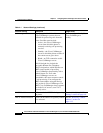
Chapter 4 Configuring Network Settings on the Cisco IP Phone
Verifying Network Settings
4-6
Cisco IP Phone Administration Guide for Cisco CallManager 3.3, Cisco IP Phones 7902G/7905G/7912G
OL-6313-01
TFTP Server 1-2 TFTP Server 1 indicates the primary
Trivial File Transfer Protocol (TFTP)
server used by the phone to obtain
configuration files.
TFTP Server 2 displays the IP address of
the backup TFTP server, which is used to
obtain configuration files and software
upgrades if the primary TFTP server is
unavailable.
See the “Assigning a TFTP
Sever” section on page 4-28.
Default Router 1 Identifies the default gateway used by the
phone.
See the “Assigning a Default
Router” section on page 4-17.
DNS Servers 1-2 Indicates the Domain Name System
(DNS) server used by the phone to resolve
the host name of the TFTP server,
Cisco CallManager system and web server
host names.
See the “Assigning DNS
Servers” section on
page 4-22.
Operational VLAN Id Indicates the auxiliary Virtual Local Area
Network (VLAN) configured on a Cisco
Catalyst switch in which the phone is a
member.
If the phone has not received an auxiliary
VLAN, then the operational VLAN
reflects the Administrative VLAN.
If neither the auxiliary VLAN nor the
Administrative VLAN are configured,
then the Operational VLAN field is blank.
Obtained via Cisco Discovery
Protocol (CDP) from the
switch to which the phone is
attached.
Admin. VLAN Id Indicates the auxiliary VLAN in which the
phone is a member.
Used only if the phone does not receive an
auxiliary VLAN from the switch.
The Administrative VLAN is ignored if an
auxiliary VLAN is obtained from the
switch.
See the “Configuring VLAN
Settings” section on
page 4-25.
Table 4-1 Network Settings (continued)
Network Setting Description Usage Notes


















